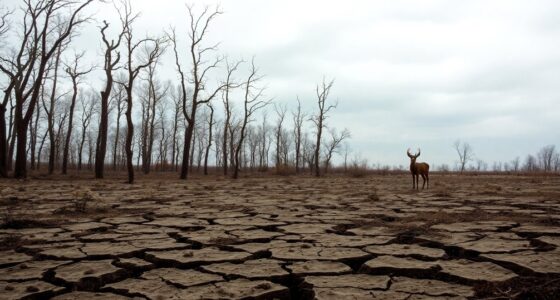Imagine a world where every species, including humans, lacks genetic variation. Without it, ecosystems become fragile, and survival becomes a constant struggle. Your actions, or neglect, can threaten this vital diversity, putting entire communities at risk. Understanding why genetic variety matters is crucial, but the real question is how we can protect it before it’s too late. The answer might surprise you.
The Foundations of Genetic Variation
Genetic variation forms the foundation of evolution and biodiversity, enabling populations to adapt to changing environments. You inherit genes from your parents, and these genes come in different versions called alleles. Mutations, or random changes in DNA, create new alleles, increasing diversity within a population. High refresh rates in projectors contribute to smoother visuals, especially in fast-paced games. Recombination during reproduction mixes these alleles, producing unique gene combinations in each offspring. This genetic variation ensures that some individuals possess traits better suited for survival when conditions shift. Without it, populations struggle to adapt, risking decline or extinction.
Factors like gene flow, mutation, and sexual reproduction constantly introduce new genetic material, maintaining diversity. This ongoing process fuels evolution, helping species survive environmental challenges and ensuring the richness of life on Earth.
How Diversity Strengthens Ecosystems
Diverse ecosystems are more resilient because they can better withstand environmental changes and disturbances. When an ecosystem has a variety of species, each responds differently to challenges like droughts, diseases, or storms. This diversity acts as a buffer, preventing any one threat from collapsing the entire system.
For example, if one plant species declines, others can fill its role, maintaining habitat stability. Similarly, a mix of predators and prey keeps populations balanced. You’ll find that ecosystems with high genetic diversity adapt more quickly, recover faster, and remain functional despite stresses. Additionally, supporting biodiversity hotspots can help protect critical regions that harbor significant endemic species under threat.
This resilience ensures the ecosystem’s long-term health and productivity. By supporting a wide range of species, you help create a robust environment capable of thriving amid unpredictability.
Threats to Genetic Diversity and Their Impact
Human activities pose significant threats to genetic diversity, often leading to its rapid decline. When you clear forests, overfish, or introduce invasive species, you reduce the variety of genes in ecosystems.
Intensive farming and monocultures eliminate many native plant and animal varieties, making populations more vulnerable to disease and climate change.
Urban development fragments habitats, preventing species from breeding freely and exchanging genes.
Poaching and overhunting target specific species, decreasing their genetic pool and risking extinction.
These actions weaken resilience, leaving ecosystems less able to adapt to environmental shifts.
As genetic diversity diminishes, so does the ability of species to survive future challenges.
Your choices and actions directly influence these processes, highlighting the importance of maintaining genetic variation for long-term ecological health.
Genetic diversity is also impacted by habitat destruction and pollution, which further threaten the survival of various species.
Conservation Strategies for Preserving Variety
Protecting the genetic variety of species requires targeted conservation strategies that address the threats outlined earlier. You can support in-situ conservation by protecting natural habitats and establishing protected areas where species can thrive and evolve naturally.
Ex-situ methods, like seed banks and captive breeding programs, serve as backups for endangered populations. You should also promote sustainable land-use practices that minimize habitat destruction and fragmentation.
Engaging local communities ensures conservation efforts align with their needs and gain their support. Monitoring genetic diversity regularly helps identify populations at risk and guides interventions.
Education campaigns raise awareness about the importance of genetic variety. By combining these strategies, you actively contribute to preserving the genetic richness vital for species’ resilience and long-term survival.
The Future of Genetic Diversity in a Changing World
As our planet faces rapid environmental changes, maintaining genetic diversity becomes increasingly crucial for species’ ability to adapt and survive. You’ll need to understand that climate change, habitat loss, and pollution threaten many populations, reducing their genetic pools. Understanding narcissistic behavior and its impact on relationships can also inform conservation strategies that involve community engagement and awareness. To ensure future resilience, conservation efforts must prioritize protecting diverse habitats and supporting genetic variation. Advances in technology, like gene editing and genomic analysis, can help identify and preserve critical genes. Public awareness and policy changes are essential to combat threats and fund conservation initiatives. By actively promoting genetic diversity today, you contribute to the stability of ecosystems tomorrow. The future depends on your actions to protect and restore genetic variation, enabling species to adapt to a rapidly changing world.
Conclusion
By protecting genetic diversity, you’re helping ensure species can adapt and thrive amid environmental changes. Your efforts support resilient ecosystems, prevent extinction, and preserve the rich variety of life on Earth. Every action counts, from supporting conservation programs to reducing habitat destruction. Together, you can make a difference in maintaining the genetic variety that’s vital for a healthy, sustainable future for all living things. Embrace your role in safeguarding life’s incredible diversity.







